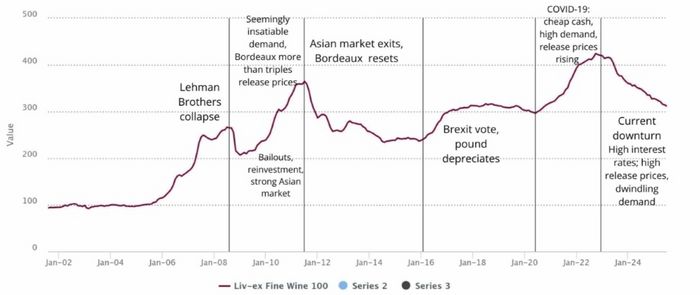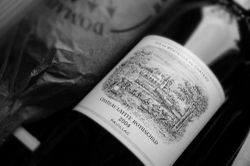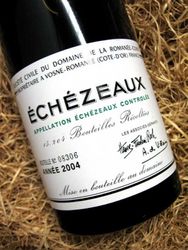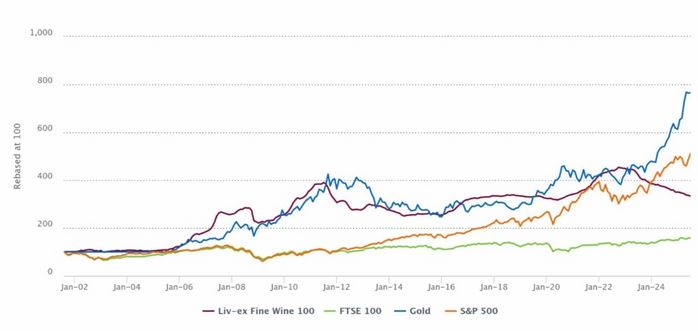What investors need to know and why H2 2025 is a key time to buy for strong returns
Like all assets, the fine wine market has periods of growth and decline. It is through these movements that investors can make their money work for them by identifying those assets with the potential for growth and buying and selling at the optimum times to achieve the best possible returns.
Fine wine market cycles explained

Source: Liv-ex.com 30th July 2025
In the 21st century the fine wine sector has seen three marked periods of downturn. The first was triggered by the 2008 crisis in financial markets which instigated an all-asset sell off as investors fled to cash. However, this quickly turned, in 2009, to a Bordeaux boom as tangible fine wine proved to be a relative safe haven in a period of extreme uncertainty in financial markets and global economies.
 The fine wine market at that time was Bordeaux-centric with the region accounting for more than 90 per cent of the fine wine sold on Liv-ex.
The fine wine market at that time was Bordeaux-centric with the region accounting for more than 90 per cent of the fine wine sold on Liv-ex.
This narrow focus, particularly on vintages of the five First Growths (Haut Brion, Lafite Rothschild, Latour, Margaux, Mouton Rothschild) saw release prices and values on the secondary market grow rapidly, riding an upward trend and, ultimately, over-inflate to peak in 2011.
The start of the second downturn in 2011 was in response to the unsustainable values for top Bordeaux, as investors sought value elsewhere. They turned to Burgundy, Italy and Champagne causing prices on the secondary market to fall. The timing also coincided with the Chinese Government crackdown on corporate corruption and ‘gift-giving’ which led to Asian buyers leaving the market. As Bordeaux, and primarily the First Growths, were the market at the time the slide in values was the steepest the market has ever recorded.
 In the following years the composition of the market became more diversified, with top Burgundies, Super Tuscans, investable Champagne and Californian cult wines more widely traded and accessible to investors. Prices averaged down from the heady heights the First Growths had been driven to, and the market became more robust.
In the following years the composition of the market became more diversified, with top Burgundies, Super Tuscans, investable Champagne and Californian cult wines more widely traded and accessible to investors. Prices averaged down from the heady heights the First Growths had been driven to, and the market became more robust.
In 2016 the Brexit vote in the UK triggered uncertainty in financial markets and once again, tangible assets like fine wine became attractive targets for investors. Added appeal was the advancement of key dynamics with more investor information available providing greater transparency and efficiency in the market.
Covid 19’s impact on the world in Q1 2020 was the start of the next significant boom and the fine wine bull run that saw Burgundy, Champagne and Italy as firmly established for wine investors as Bordeaux and further broadened the sector’s accessibility and trade into the other key wine regions such as Piedmont.
Rising inflation and demand drove values and trade to the highest levels on record to peak in October 2022. Release prices, once again rose to levels that the market struggled to swallow. Add to this, war in Ukraine and Gaza and Trump’s return to the White House and since then, the sector has been in the longest downturn endured in modern times.
Fine Wine v Equities

Source: Liv-ex.com 30th July 2025
The key Liv-ex 100 benchmark has fallen by -26.6% since its peak in September 2022 and is down -5.2% year-to-date in 2025. In terms of cycle comparison, the latest downturn is most closely compared to 2011 due to the similar impact of ‘overly-ambitious’ release pricing particularly for Bordeaux, and the withdrawal of a key buyer segment to the market – this time US buyers due to Trump’s tariffs.
Why is H2 2025 an important opportunity for wine investors?
In the fine wine world, history shows that what goes down will come back up.
Past data shows that periods of growth consistently follow periods of decline. Market analysis also reveals that whilst there has been continued pressure on prices this year, the decline has slowed, trade volume and value on the secondary market has increased and a percentage of wines are seeing prices bottom out and growth.
It will only take a tiny fraction of the equity market to reinvest in fine wine to cause a significant increase in demand to take place. Those investors looking to buy at the bottom of the curve must consider investing in the market in H2 2025 as a key priority.
Our view
The opportunity for investors to start a fine wine portfolio, or add to one and potentially average down on investment cost, and position for growth with some of the most sought-after wines at the start of a market recovery is apparent.
For more information on the fine wine market this year, see our latest Report. To find out which wines we would recommend for investment in H2 2025, contact our expert team on 0203 384 2262.

